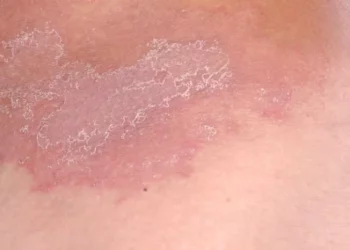Ringworm, despite its name, isn’t caused by a worm but rather a fungus that infects the skin, hair, or nails. It’s a common misconception that ringworm can be deadly, but in reality, it’s typically a mild and treatable condition. Let’s delve into the facts surrounding ringworm, its potential risks, and how to manage this fungal infection.
What is Ringworm?
Ringworm, known medically as dermatophytosis or tinea, is a fungal infection that can affect different parts of the body. The name “ringworm” derives from the characteristic red, circular rash that often appears on the skin. This infection is caused by various types of fungi called dermatophytes, which thrive on the outer layer of skin and can also invade hair and nails.
Contrary to popular belief, ringworm isn’t caused by poor hygiene. It’s highly contagious and can spread through direct contact with an infected person or animal, or by touching contaminated objects or surfaces.
Understanding the Fungal Culprit
The fungi responsible for ringworm belong to several genera, including Trichophyton, Microsporum, and Epidermophyton. These fungi feed on keratin, a protein found in the skin’s outer layer, hair, and nails. When they infect the skin, they can lead to the characteristic symptoms of ringworm.
The specific type of ringworm infection depends on its location:
- Tinea corporis: Ringworm of the body
- Tinea capitis: Ringworm of the scalp
- Tinea cruris: Jock itch (in the groin area)
- Tinea pedis: Athlete’s foot
- Tinea unguium: Ringworm of the nails
Each type of ringworm can present with slightly different symptoms and may require specific treatments.
Debunking the Myth: Can Ringworm Kill You?
The notion that ringworm can be fatal is a misconception. Ringworm itself is not life-threatening, and most cases can be effectively treated with antifungal medications. However, complications can arise if the infection is left untreated or if it spreads extensively.
Although rare, severe cases of ringworm can potentially lead to complications such as:
1. Secondary Bacterial Infections: Scratching the infected area can break the skin barrier, allowing bacteria to invade and cause secondary infections.
2. Permanent Scarring: Chronic or severe ringworm can lead to scarring of the affected skin or scalp, particularly if the infection causes hair loss or destruction of hair follicles.
3. Disseminated Infection: In individuals with weakened immune systems, such as those with HIV/AIDS or undergoing chemotherapy, ringworm can spread beyond the skin to other organs, leading to a more serious condition known as disseminated or systemic fungal infection.
While these complications are uncommon, it’s crucial to seek medical attention promptly if you suspect you have ringworm, especially if you are at higher risk due to a weakened immune system.
Risk Factors for Ringworm Complications
Certain factors can increase the risk of complications from ringworm:
1. Immune Compromise: Individuals with weakened immune systems, either due to medical conditions or medications, are more susceptible to severe fungal infections.
2. Poor Hygiene and Overcrowded Living Conditions: Although ringworm itself isn’t caused by poor hygiene, living in crowded or unhygienic conditions can increase the risk of exposure and transmission.
3. Delay in Treatment: Ignoring the signs of ringworm or using ineffective home remedies can allow the infection to worsen and lead to complications.
4. Frequent Skin-to-Skin Contact: People who participate in contact sports, share personal items, or have close contact with animals are more likely to contract and spread ringworm.
Recognizing Ringworm Symptoms
The symptoms of ringworm vary depending on the location and severity of the infection:
1. Red, Itchy Rash: Ringworm typically presents as a red, scaly rash that may be ring-shaped and slightly raised. The rash can be accompanied by itching, burning, or pain.
2. Hair Loss: In cases of scalp ringworm (tinea capitis), hair loss and scaling may occur.
3. Brittle, Discolored Nails: Nail ringworm (tinea unguium) can cause nails to become thickened, discolored, and brittle.
If you suspect you have ringworm based on these symptoms, it’s important to consult a healthcare provider for an accurate diagnosis and appropriate treatment.
Treatment and Prevention
Treatment for ringworm usually involves topical or oral antifungal medications. Over-the-counter antifungal creams, lotions, or powders may be sufficient for mild cases, while more severe or widespread infections may require prescription-strength medications.
To prevent the spread of ringworm and reduce the risk of complications:
1. Practice Good Hygiene: Wash your hands regularly, especially after touching pets or animals, and keep your skin clean and dry.
2. Avoid Sharing Personal Items: Do not share clothing, towels, or other personal items with someone who has ringworm.
3. Treat Infected Pets: If your pet has ringworm, consult a veterinarian for appropriate treatment to prevent transmission to humans.
4. Maintain Clean Living Conditions: Keep your living spaces, especially common areas, clean and well-ventilated to reduce fungal growth.
Conclusion
In summary, ringworm is a common fungal infection of the skin, hair, or nails caused by dermatophytes. While it’s not life-threatening in most cases, complications can arise if the infection is left untreated or if it spreads extensively. Prompt diagnosis and treatment are essential to manage ringworm effectively and prevent complications, especially in individuals with weakened immune systems. By understanding the facts about ringworm and adopting preventive measures, you can minimize the risk of infection and ensure optimal skin health. If you suspect you have ringworm or have concerns about fungal infections, consult a healthcare provider for personalized advice and treatment.
Related Topics:
























